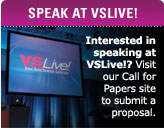Dynamic Keynotes spanning the Next Gen Development Platform, SOA, Web 2.0
Visual Studio: The Next Generation Development Platform
Sam Guckenheimer, Lead Product Planner for Orcas, Microsoft
May 15, 9 a.m.
 What will drive the next generation development platform? How are we going to use development tools, lifecycle applications and integrated platforms to ensure further productivity, quality and security? This keynote will focus on best of breed solutions which are meetings today’s development challenges and provide an overview and direction of the next release of Microsoft premier development tools and platform. Learn how Visual Studio now and tomorrow will expand your opportunities, drive further productivity and quality and allow you to tackle new challenges.
What will drive the next generation development platform? How are we going to use development tools, lifecycle applications and integrated platforms to ensure further productivity, quality and security? This keynote will focus on best of breed solutions which are meetings today’s development challenges and provide an overview and direction of the next release of Microsoft premier development tools and platform. Learn how Visual Studio now and tomorrow will expand your opportunities, drive further productivity and quality and allow you to tackle new challenges.
Richard Turner, Microsoft
May 16, 9 a.m.
 WinFX is the new managed code programming model for Windows. It is a superset of the .NET Framework, combining the power of the .NET Framework 2.0 APIs with new technologies for building applications that have visually stunning user experiences, seamless and secure communication, and the ability to model a range of business processes. In this keynote, you’ll get the big picture on WinFX, including an overview of its component technologies (WPF, “InfoCard”, WCF and WF) and learn how WinFX works with Visual Studio 2005. You’ll walk away understanding how WinFX simplifies software development and enables you to build new types of applications.
WinFX is the new managed code programming model for Windows. It is a superset of the .NET Framework, combining the power of the .NET Framework 2.0 APIs with new technologies for building applications that have visually stunning user experiences, seamless and secure communication, and the ability to model a range of business processes. In this keynote, you’ll get the big picture on WinFX, including an overview of its component technologies (WPF, “InfoCard”, WCF and WF) and learn how WinFX works with Visual Studio 2005. You’ll walk away understanding how WinFX simplifies software development and enables you to build new types of applications.
What Goes Into the Sausage: Lessons from "the Factory Floor" on How Microsoft Does Software Engineering
Russ Ryan, Product Unit Manager, Developer Division Customer Product-Lifecycle Experience Team, MIcrosoft
May 16, 2 p.m.
 How does the Microsoft developer division produce software? As we roll out Visual Studio 2005 lots of people have asked about our development process and the tools we use. We learned a lot during the VS 2005(Whidbey) development cycle. This talk will show how we started out, what we learned, and show some of the engineering practices and improvements we have set in place to make the next version even better.
How does the Microsoft developer division produce software? As we roll out Visual Studio 2005 lots of people have asked about our development process and the tools we use. We learned a lot during the VS 2005(Whidbey) development cycle. This talk will show how we started out, what we learned, and show some of the engineering practices and improvements we have set in place to make the next version even better.
Software Architecture on the Edge: Moving Beyond SOA
John deVadoss, Director, Architecture Strategy, Microsoft
May 17, 9 a.m.
 The software landscape is rapidly changing, and the need for a new architecture to accommodate these changes is rapidly emerging. The emergence of the software as a service (SaaS) paradigm has created opportunity for development of powerful applications that operate on the edge as we as within the cloud. The business and social models that drive software and commerce are changing as well. All of this means that software architects have to take a step back and think about what lies over the horizon. To move beyond SOA means finding a way to connect the Edge to the existing services infrastructure. This talk will take a look at a new architecture to address this issue.
The software landscape is rapidly changing, and the need for a new architecture to accommodate these changes is rapidly emerging. The emergence of the software as a service (SaaS) paradigm has created opportunity for development of powerful applications that operate on the edge as we as within the cloud. The business and social models that drive software and commerce are changing as well. All of this means that software architects have to take a step back and think about what lies over the horizon. To move beyond SOA means finding a way to connect the Edge to the existing services infrastructure. This talk will take a look at a new architecture to address this issue.
![]() Building the Next Generation of Web Applications Using
Building the Next Generation of Web Applications Using
ASP.NET and “Atlas”
Andres Sanabria, Lead Program Manager for ASP.NET, Microsoft
May 17, 2 p.m.
 Come and see the power that ASP.NET codename “Atlas” brings to Ajax development. “Atlas” is a new cross-platform/cross-browser framework for building rich, client-centric AJAX-style Web applications. During this demo-heavy presentation you will see how to enhance your existing ASP.NET Web site with the “Atlas” client & server controls and seamlessly access remote application services. You will also see how the unique blend of “Atlas” client and server side components can help enhance any application on the Web.
Come and see the power that ASP.NET codename “Atlas” brings to Ajax development. “Atlas” is a new cross-platform/cross-browser framework for building rich, client-centric AJAX-style Web applications. During this demo-heavy presentation you will see how to enhance your existing ASP.NET Web site with the “Atlas” client & server controls and seamlessly access remote application services. You will also see how the unique blend of “Atlas” client and server side components can help enhance any application on the Web.
Modern Web Development from Mash-Ups to IM-Based Bots
Scott Swanson, Group Product Planner for the Windows Live/MSN Messenger Platform, Microsoft
 Tentative description / New session under development:
Tentative description / New session under development:
Use the skills you already have as a Visual Studio-developer to leverage emerging Web-based technologies. Create interactive bots built atop instant messengers, integrate virtual maps with IM. Learn what opportunities Windows Live opens up for VS users. Take a cruise through the MSN Messenger Activity API and learn how you can build interactive peer to peer applications in Messenger. The Activity API enables you to take advantage of MSN Messenger’s communication infrastructure to interact with IM conversations and pass data between MSN Messenger clients without having to worry about the normal Internet connectivity issues of crossing firewalls, NATs, proxies, etc. The Activity API enables you to build rich interactive applications for an audience of 170 million MSN Messenger users world-wide.




